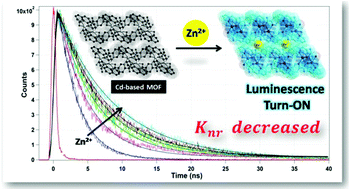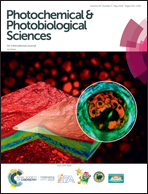Effect of charge transfer and structural rigidity on divergent luminescence response of a metal organic framework towards different metal ions: luminescence lifetime decay experiments and DFT calculations†
Abstract
We have thoroughly studied the luminescence behaviour of a cadmium based MOF, [Cd(C12N2H8)(C7N1O4H3)] {C12N2H8 = 1,10-phenanthroline, C7N1O4H3 = 2,5-pyridine dicarboxylate}, 1. Both steady-state and time-resolved luminescence spectroscopic experiments were performed to understand the dissimilar responses of compound 1 towards different metal ions in aqueous medium. Upon excitation at 280 nm, compound 1 showed a luminescence spectrum centered at 365 nm, which exhibited a three-fold turn-on in the presence of a trace amount of Zn2+ in aqueous solution, whereas in the presence of Co2+, Hg2+, Ni2+, Fe2+ and Cu2+ the luminescence of compound 1 got largely quenched. Compound 1 did not show any response in the presence of other common metal ions such as K+, Mg2+, Na+, Mn2+, and Cr3+. By analysing all the experimental results, we successfully explained the versatile luminescence behaviour of compound 1. The turn-on of luminescence in the presence of Zn2+ ions was due to coordination bond formation and enhancement of the rigidity of compound 1 which resulted in the reduction of non-radiative decay processes to a large extent. The quenching of luminescence in the presence of transition metal ions was found to be static in nature, and was due to the possibility of ligand to metal charge transfer using the vacant d-orbital of the metal ions. In the case of Hg2+ which is a closed cell heavy metal ion, the quenching of luminescence was also static in nature and was due to a two-way charge transfer mechanism. We have also performed density functional theory calculations and obtained supportive results for the proposed mechanisms of luminescence turn-on and quenching. Moreover, compound 1 could be established as a selective and efficient sensor of Zn2+ in aqueous solution even in the presence of Cd2+ and other metal ions.



 Please wait while we load your content...
Please wait while we load your content...